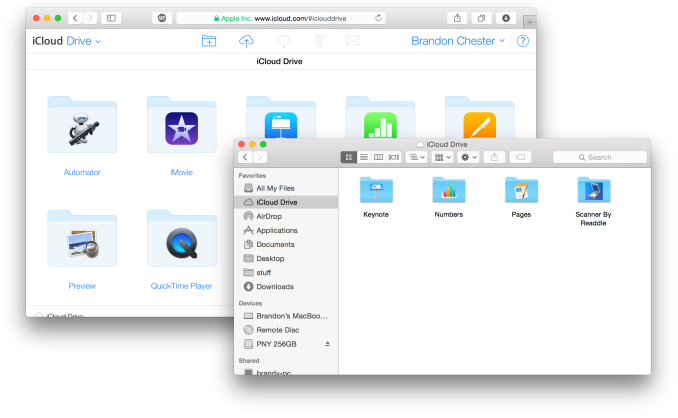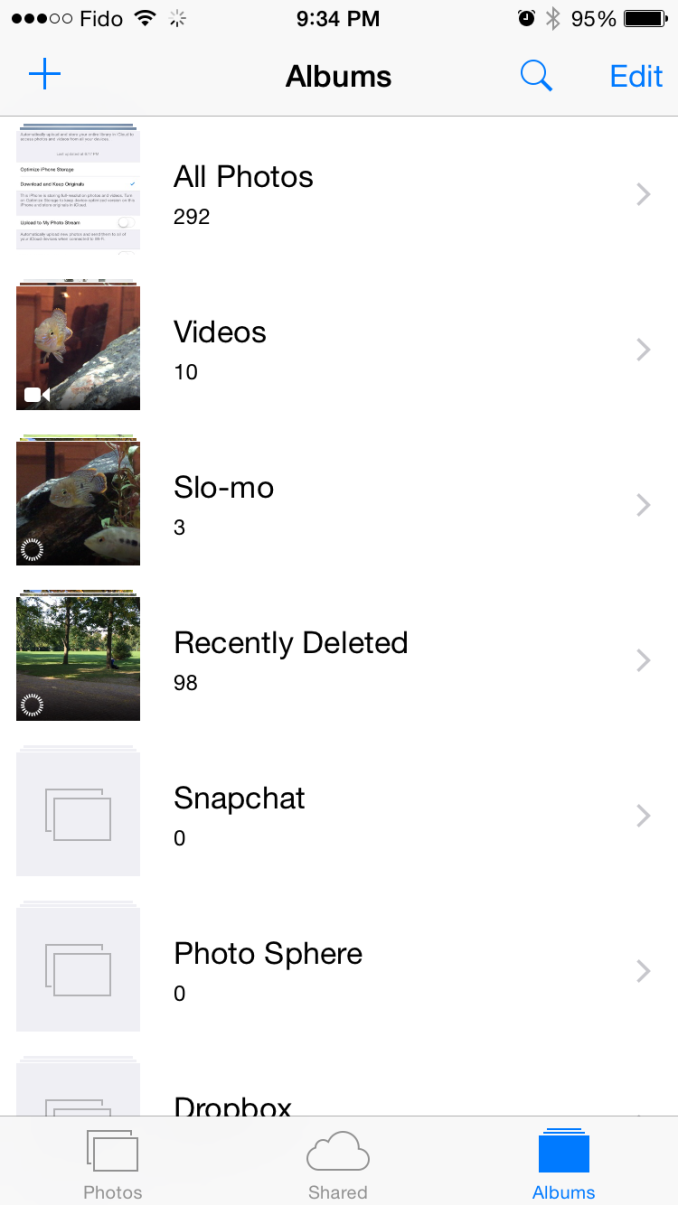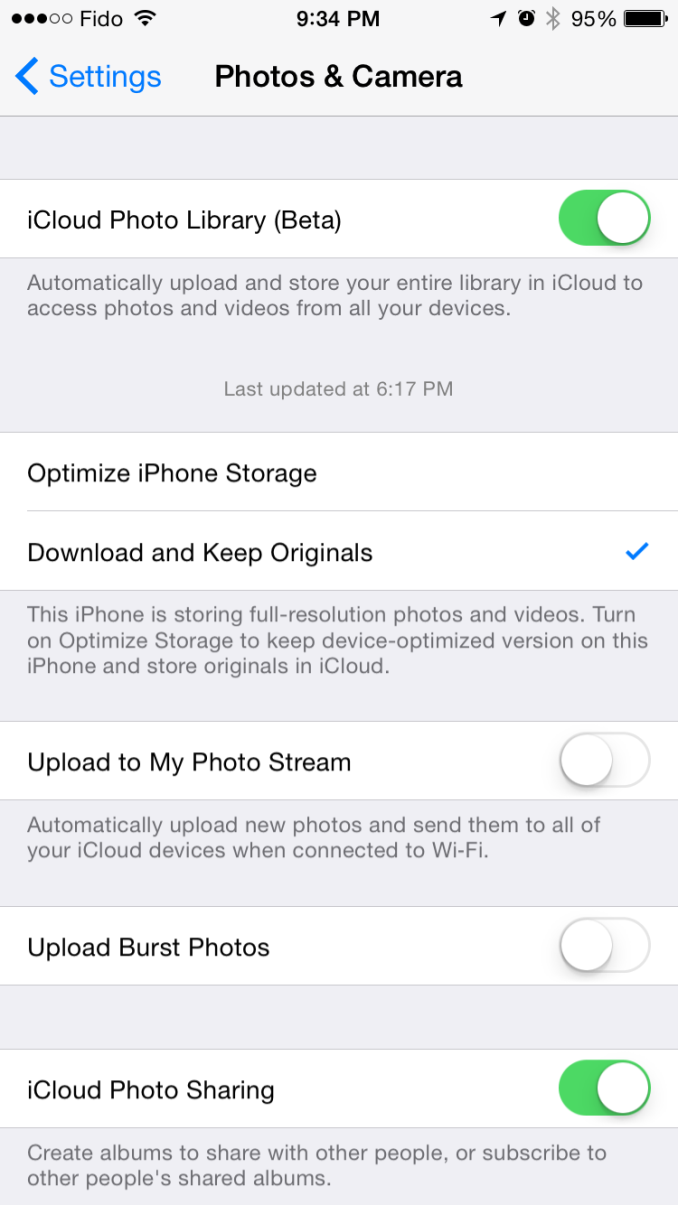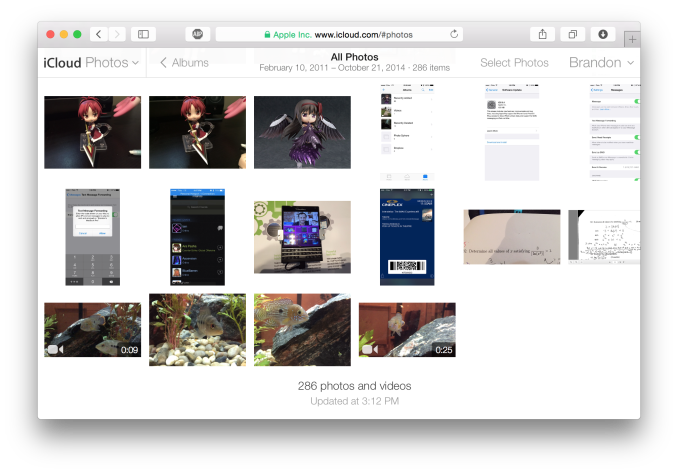A Look At OS X Yosemite And iOS 8.1
by Brandon Chester on October 27, 2014 8:00 AM ESTiCloud Drive and Photo Library
At WWDC 2014 Apple introduced a number of significant additions and improvements to their iCloud service for developers and consumers. On the user side we got iCloud Drive and iCloud Photos. Both of these features position themselves against the offerings from other companies in the increasingly competitive cloud storage space. Apple's advantage within their own ecosystem is how iCloud integrates with their own systems better than Dropbox, OneDrive, or Google Drive ever can. Integration cannot keep a service alive if it becomes stagnant though, and these two features are very necessary additions.
iCloud Drive
iCloud Drive is arguably the more important and interesting of the two features. In the past, iCloud has been something like a magic black box that users can never access or even look into. Files would be created in an application, sent to iCloud, and hopefully they would show up on your other devices. This type of model makes for a great document synchronizing solution, but it's not very good at some of the other things people have grown to expect from a cloud storage service. Apple had to build something that allowed users to manage their documents stored in iCloud, including the ability to add or remove files as needed without having to go into each individual iCloud enabled application.
As a file storage service, iCloud Drive functions exactly how you would expect. You can make folders, and upload files to those folders which can be accessed on any other device with access to iCloud drive. In addition to those files, iCloud Drive also houses the files for any iCloud enabled application. As you can see above, each iWork and iLife application also has its files accessible in iCloud Drive, along with third party iCloud enabled apps like Scanner by Readdle.
Your drive can be accessed in a few different ways. In OS X it's integrated right into Finder and is listed in Favorites by default. Windows users can download Apple's iCloud Control Panel to have it accessible via Windows Explorer. I've avoided the Windows solution because my past experience is that having iCloud Control Panel do anything with to Windows Explorer will make it crash Windows Explorer. While I haven't experienced that while using the new Control Panel 4.0 for the purposes of this review, I still don't trust it.
The third method is to access it from iCloud.com. You would think that with these 3 options, including a web based option, Apple would have every platform covered. Unfortunately they don't. There is no way to directly manage iCloud Drive from an iOS device because iCloud.com displays a special page with links to get information on setting up iCloud and installing Find my iPhone. Applications that integrate with iCloud have the ability to open documents stored in iCloud Drive using the document picker, but there's no way to move or delete other files. I don't know if this is just an oversight or if Apple doesn't want it accessible via mobile but it is honestly a necessary feature and I hope to see it added soon either through an app or through iCloud.com on iOS.
iCloud Photos
iCloud Photo Library was released with iOS 8.1 in the form of a public beta. I actually wrote about it in my initial iOS 8 review due to confusion regarding its availability. It was only near the end of Apple's beta cycle that they revealed SMS Forwarding and iCloud Photo Library would be arriving with a later release. On top of that, using the OS X Yosemite preview would cause the option to reveal itself on your iOS devices. As a result, my devices running the gold master build still had the feature and I was unaware that for most users it would not be accessible until October. But now October has come and we can take a closer look at iCloud Photo Library in its beta form. Users who want to try it out just need to opt into the beta in the Photos & Camera section of the Settings application. Doing so will change the name of Camera Roll to All Photos in the Photos app.
As I've stated before, iCloud Photo Library is not the same as Photo Stream. Photo Stream is really just a method of pushing your photos between all your devices. It relies entirely on local storage and the photos are removed from iCloud after 30 days. iCloud Photo Library keeps all of your pictures in the cloud, and keeps the most recent and frequently accessed ones locally on your device. This is often referred to as nearline storage. Users can also specify to download copies that are optimized for their display resolution which will save space compared to storing full resolution copies on local storage.
iCloud Photo Library is definitely a great feature, but right now the experience is missing a few key things. On iOS it works very well due to how the entire photo experience is within the Photos application. On OS X it's still lacking. Some people may feel it's unfair to criticize certain aspects due to the fact that the feature is technically a beta, but oversights need to be addressed for them to be fixed.
The biggest issue for me is that Apple's Photos application for OS X won't be shipping until early 2015. That's quite a long time after the initial release of Yosemite, and an even longer time after iOS 8 was released. This means that there is currently no way to access photos stored in iCloud on a Mac unless it is done through the web interface. It's an okay solution for now, but the web interface is nothing spectacular. It's essentially the iPad Photos app interface but in a web browser. My biggest issue with it is that it doesn't actually scale. The Safari window with iCloud Photos above is as small as you can make the window without introducing horizontal scrolling. Making the window larger doesn't show more photos on the screen, it just makes the thumbnails bigger. This contrasts with iCloud Drive's web interface which does scale the arrangement of folders based on the size and shape of the window.
There is definitely a lot of pressure involved in trying to ship two major operating system updates around the same time every year, and to pack in new features that work across both of them. Apple made it clear at WWDC 2014 that Photos on OS X wasn't going to be ready until 2015, but I think the issue created by that could have been addressed much better by updating iPhoto to support iCloud Photo Library rather than relying on the web interface.














173 Comments
View All Comments
Impulses - Friday, October 31, 2014 - link
Clearly that just means you're a shill, doing it for the money rather than the love of all things out of Cupertino.jk
KoolAidMan1 - Monday, October 27, 2014 - link
Its all because not enough negative things were said, right?Middle aged fanboys and their unfulfilled negativity quotas, how sad...
retrospooty - Monday, October 27, 2014 - link
Generally speaking tech articles will list the good and bad and diplay it for the user to determine what fits best. I honestly cannot recall the last time I saw anything at Anandtech on the neg. 1/2 of that equation with regards to Apple products... And there has been quite of that alot lately... Anandtech? Amazingly quiet.But, drink on kool aid man. Your name says it all.
KoolAidMan1 - Tuesday, October 28, 2014 - link
Or maybe all the positive reviews you see on the internet are because its actually good?Your love of conspiracies rivals 9/11 truthers
retrospooty - Tuesday, October 28, 2014 - link
OR MAybe I see all of the negative reports of the heinous slowness IOS8 has caused and the various other problems and bugs that go along with it... My once nice iPad 4 is now slower scrolling through web pages than my old Droid3 w/OMAP CPU on Gingerbread FFS. Then I read an article at a once great tech site that has been my home page for over 15 years and see "Its a little bluebird on my shoulder".I am not calling that a conspiracy, but it is a very one sided take on things... Which as I said is par for the course at Anandtech for the past several years. If you cant see that then you are far too biased to even talk about it... Oh wait... n/m
Brett Howse - Tuesday, October 28, 2014 - link
Let's be fair here this is right from Brandon's iOS8 review: "Given that the iPad 3 I have for testing falls into both the Apple A5(X) camp and the iPad camp, I won't be updating it to iOS 8. While the new features like SMS Relay will be nice, the missing features and issues like keyboard lag outweigh the benefits of updating."KoolAidMan1 - Tuesday, October 28, 2014 - link
The iPad Air was my first one. It runs everything great in iOS 8, totally fast and smooth.I can't speak for your two year old hardware. I know my GS3 from the same year was choppy and slow right when I bought it, wifi was bugged after an update, and so on. Brainwashed apologists deflect that but whatever.
Nothing is perfect, even your precious, but try and keep your head together.
retrospooty - Wednesday, October 29, 2014 - link
It doesn't require you to "speak to" it. It's all over the place. The slowness, the apps crashing, even on the pliant 6 and 6 plus.KoolAidMan1 - Wednesday, October 29, 2014 - link
iPhone 6 here, solid. No slowness, no stutters, no crashing. Oh, right, I must be lying...And you're still going with the bendgate thing when only dozens out of tens of millions of units have bent?
Suckers that feed on news cycles are funny.
KoolAidMan1 - Wednesday, October 29, 2014 - link
By the way, I just Googled for "bent iPhone" to see how big it is. The stories run from September 25th to October 1st, then nothing.Only a couple dozen out of tens of millions of units have bent. If this was actually a problem then it would still be a part of the news cycle, maybe even a recall.
I changed my mind. Middle aged fanboys desperately grasping at dead news stories from a month ago are what's actually funny.